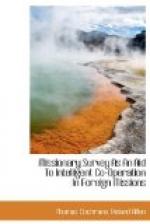-------------------------------------------------------
---- Population. : Total : Total Non- : Proportion : Christians. : Christians. : of Christians to : : : Non-Christians. ----------------------------------------------------------- 32,571,000 : 534,238 : 32,036,762 : 1 to 60 -----------------------------------------------------------<
/pre>One Christian to every sixty non-Christians gives us a totally different impression. We begin to feel that if only the Christians awoke to their duty they could influence the whole population profoundly. That is precisely the effect produced upon the Christians by a missionary survey undertaken with them, and understood by them; they begin to see the immensity of the work to be done, they begin to see that it can be done.
There should properly then here be two tables parallel to the first two. Thus:—
-------------------------------------------------------
-------------- | Number of | Number of | | | Occupied | Unoccupied | Proportion of |Remarks Area. | Cities, Towns, | Cities, Towns, | Occupied to |and | Villages. | Villages. | Unoccupied. |Conclusions. ------|----------------|----------------|---------------|---
--------- | | | | ______|________________|________________|_______________|___
_________-------------------------------------------------------
--------------- Total | Total | Total Non- | Proportion of | Remarks Population. | Christian | Christian | Christian to | and | Population. | Population. | Non-Christian. |Conclusions. ------------|-------------|-------------|----------------|--
---------- | | | | ____________|_____________|_____________|________________|__
__________Observe what light is thrown upon a district by the mere juxtaposition of those few facts. I think those two tables alone should suffice to prove that a survey which regarded only a very few factors might be of immense service, if those who used it kept clearly before them its partial character and did not allow themselves to treat it as complete.
But, unfortunately, these first facts which we have desired are, like other facts of importance, procured only with difficulty and toil. In order to fill up the preceding tables the missionary surveyor must be able to state what is the area and what the population in the station district. But some could not supply that information. Its acquisition might involve a journey of many months given up to careful examination and inquiry. It is no small demand to make. In many cases a reasoned estimate is indeed the only possible statement; but as we have already argued careful estimates are invaluable, and where a census does not exist they give us for the time something to work upon.
Where the physical survey can be undertaken it is most illuminating work, illuminating both to the missionaries and to their native helpers, who often gain an entirely new view of their work and its possibilities from such personal examination. Testimony to the value of this experience is growing daily in weight and volume.




